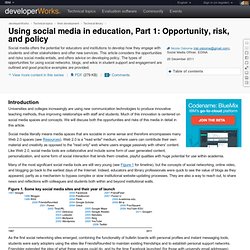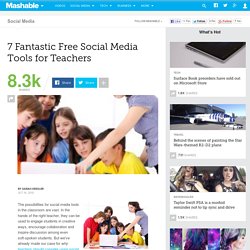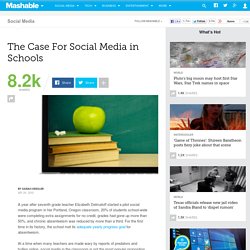

Using social media in education, Part 1: Opportunity, risk, and policy. Introduction Universities and colleges increasingly are using new communication technologies to produce innovative teaching methods, thus improving relationships with staff and students.

Much of this innovation is centered on social media spaces and concepts. We will discuss both the opportunities and risks of this media in detail in this article. Social media literally means media spaces that are sociable in some sense and therefore encompasses many Web 2.0 spaces (see Resources). Web 2.0 is a "read write" medium, where users can contribute their own material and creativity as opposed to the "read only" web where users engage passively with others' content. Many of the most significant social media tools are still very young (see Figure 1 for timeline), but the concepts of social networking, online video, and blogging go back to the earliest days of the Internet. Figure 1. Figure 2. Note: U.S. statistics are from the Pew Internet & American Life Project. Back to top Opportunity Risk Policy. 7 Fantastic Free Social Media Tools for Teachers. The possibilities for social media tools in the classroom are vast.

In the hands of the right teacher, they can be used to engage students in creative ways, encourage collaboration and inspire discussion among even soft-spoken students. But we've already made our case for why teachers should consider using social media in their classrooms. What about the how? Even when people say they want to incorporate social media, they don't always know the best ways to do so.
It's especially daunting when those efforts can affect the education of your students. To help, we've collected seven of the the best classroom tools for incorporating social media into your lesson plans. EDU 2.0 is a lot like online course management systems Blackboard and Moodle, but with a couple of distinct advantages. The founder of software company The Mind Electric, who has roots in education, self-funded the development of EDU 2.0 in what the site describes as a "labor of love.
" The Case For Social Media in Schools. A year after seventh grade teacher Elizabeth Delmatoff started a pilot social media program in her Portland, Oregon classroom, 20% of students school-wide were completing extra assignments for no credit, grades had gone up more than 50%, and chronic absenteeism was reduced by more than a third.

For the first time in its history, the school met its adequate yearly progress goal for absenteeism. At a time when many teachers are made wary by reports of predators and bullies online, social media in the classroom is not the most popular proposition. Teachers like Delmatoff, however, are embracing it rather than banning it. They argue that the educational benefits of social media far outweigh the risks, and they worry that schools are missing out on an opportunity to incorporate learning tools the students already know how to use. What started as a Facebook-like forum where Delmatoff posted assignments has grown into a social media component for almost every subject. 1. 2. 3. 4. 5. Using social media in education, Part 2: Tools, support, and technical issues.
Social media tools in education Social media tools are changing the education landscape. These tools tend to fall into two broad categories: those primarily intended for social networking, such as Facebook or Twitter, and those that are designed for sharing user-generated content such as blogs, YouTube, or Flickr. It is the mixture of informality and ease of updating that makes social media approaches so appealing, whether mainstream tools are used, or whether niche or local social media tools are installed or developed. Le blog de la formation professionnelle et continue. L’étude récente de la Cegos sur la formation en Europe fait ressortir une diversification des modalités pédagogiques.

Un nombre important de salariés répondent apprendre via des conférences, des communautés de pratiques, des blogs, des wikis, des podcast… L’offre formation au sein de l’entreprise utilise peu (voir pas) ces modalités ce qui veut dire que les collaborateurs les utilisent en dehors du monde professionnel. C’est un enjeu pour les services formations d’enrichir leurs offres internes pour de pas laisser s’échapper ce leadership de la compétence. La révolution numérique apportée par les médias sociaux touche tous les domaines : communication, commerce, formation … Ils deviennent un réflexe pour tous au delà des « digital native ».
Je vous propose d’initier dans ce post une liste d’idées d’usages de ces nouveaux outils … ce recueil se veut collaboratif, je vais l’enrichir de vos idées et expériences. Le micro-Blogging (ex: Twitter) Le partage de photos (ex: Flickr, Picasa) Voxopop - a voice based eLearning tool.